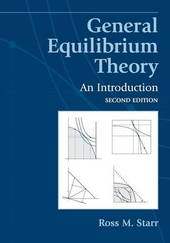
|
General Equilibrium Theory: An Introduction
Paperback / softback
Main Details
| Title |
General Equilibrium Theory: An Introduction
|
| Authors and Contributors |
By (author) Ross M. Starr
|
| Physical Properties |
| Format:Paperback / softback | | Pages:380 | | Dimensions(mm): Height 249,Width 175 |
|
| Category/Genre | Economic theory and philosophy |
|---|
| ISBN/Barcode |
9780521533867
|
| Classifications | Dewey:339.50151 |
|---|
| Audience | | Tertiary Education (US: College) | | Professional & Vocational | |
|---|
| Edition |
2nd Revised edition
|
| Illustrations |
42 Line drawings, unspecified
|
|
Publishing Details |
| Publisher |
Cambridge University Press
|
| Imprint |
Cambridge University Press
|
| Publication Date |
25 April 2011 |
| Publication Country |
United Kingdom
|
Description
General Equilibrium Theory: An Introduction presents the mathematical economic theory of price determination and resource allocation from elementary to advanced levels, suitable for advanced undergraduates and graduate students of economics. This Arrow-Debreu model (known for two of its most prominent founders, both Nobel Laureates) is the basis of modern price theory and of a wide range of applications. The new edition updates discussion throughout and expands the number and variety of exercises. It offers a revised and extended treatment of core convergence, including the case of non-convex preferences, and introduces the investigation of approximate equilibrium with U-shaped curves and non-convex preferences.
Author Biography
Ross M. Starr is Professor of Economics at the University of California, San Diego, where he has taught since 1980. He has also served on the faculties of Yale University, Connecticut, the London School of Economics and Political Science and the University of California, Davis, and he held a Guggenheim Fellowship at the University of California, Berkeley. Professor Starr's research focuses on general equilibrium theory, mathematical economics and monetary theory. He is the editor of General Equilibrium Models of Monetary Economies (1989) and coeditor of the three-volume Essays in Honor of Kenneth Arrow (Cambridge, 1986). His articles have appeared in journals such as Econometrica, Economic Theory, the Journal of Economic Theory, the Journal of Money, Credit, and Banking, the Quarterly Journal of Economics and the Review of Economic Studies. Cambridge University Press released the first edition of General Equilibrium Theory: An Introduction in 1997.
Reviews'Most books on the theory of general equilibrium have adopted the terribly arid axiomatic style illustrated in pure mathematics by Nicolas Bourbaki's treatise. That style makes no compromise with rigor. But it often defies intuition. Ross Starr's book is the best attempt so far at combining economic intuition with rigor in dealing with those staples of general equilibrium theory that are the existence and the two welfare theorems. Part A ... deals with special cases of the general equilibrium model up to the two-good, two-factor, two-agent model, something that is never done in more 'advanced' presentations. Part B is a remarkably lucid introduction to the mathematics of point-set topology needed in any serious study of the general equilibrium model. Both parts will be welcomed by undergraduate students.' Yves Balasko, University of York 'This book contains an excellent exposition of classic general equilibrium theory. While it eases the reader into the subject slowly, it does so without compromising the analytical rigor that is necessary to understand the elegant foundations of the economic model of competitive markets.' Alberto Bisin, New York University 'Ross Starr has made a fine service to the profession when preparing this new edition of his nice introductory textbook on general equilibrium theory. This volume is slim, yet fully self-contained and rigorous; it should be ... useful to advanced undergraduates and graduate students, as well as to researchers in economic theory and mathematical economics.' Jean-Michel Grandmont, Universita Ca' Foscari di Venezia, Italy, and Centre de Recherche en Economie et Statistiques, France 'A comprehensive treatment of classical general equilibrium theory from its most elementary to its most abstract formulation. Self-contained mathematical chapters and exercises at the end of each chapter make this an ideal textbook for advanced-level courses.' Paolo Siconolfi, Columbia University
|